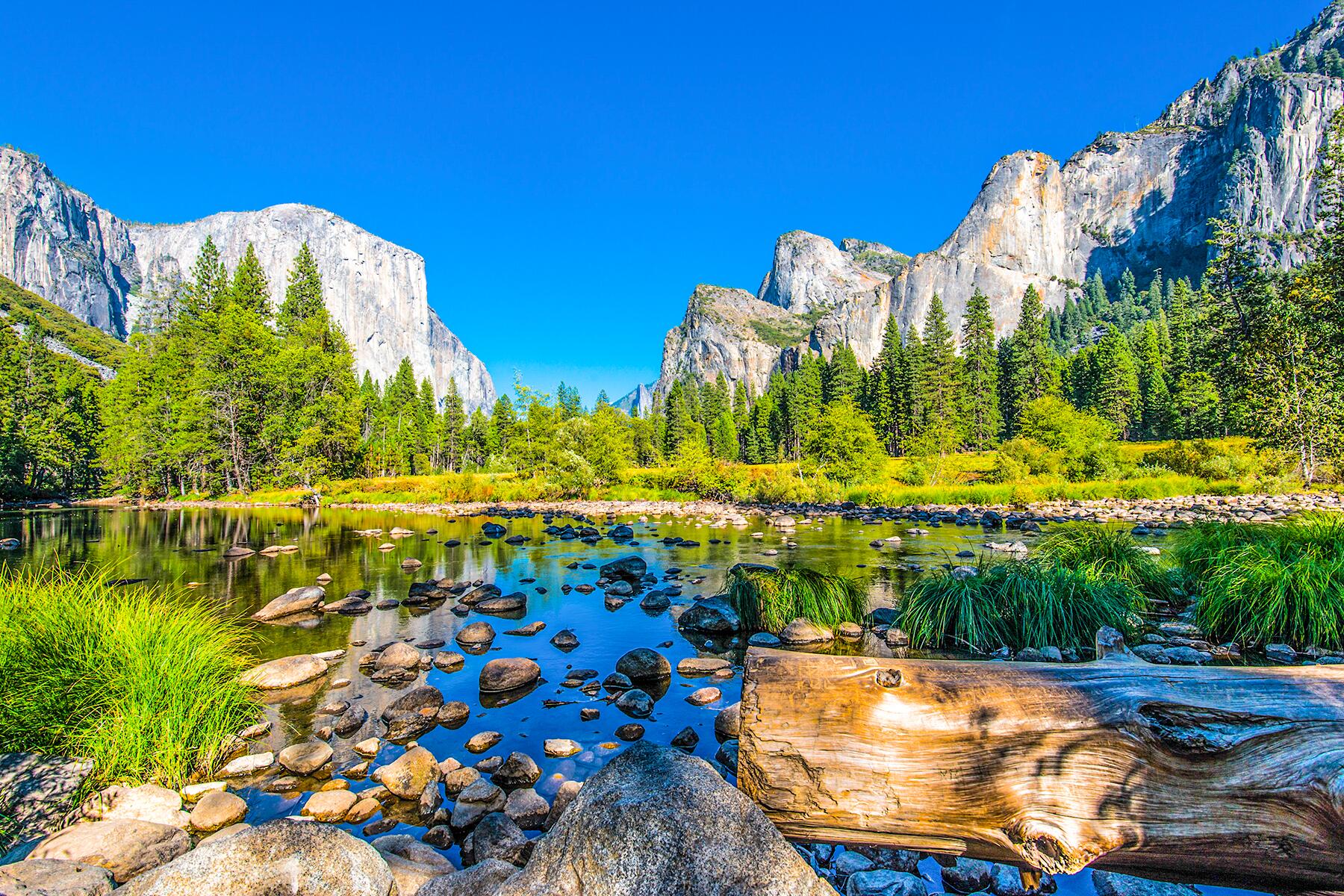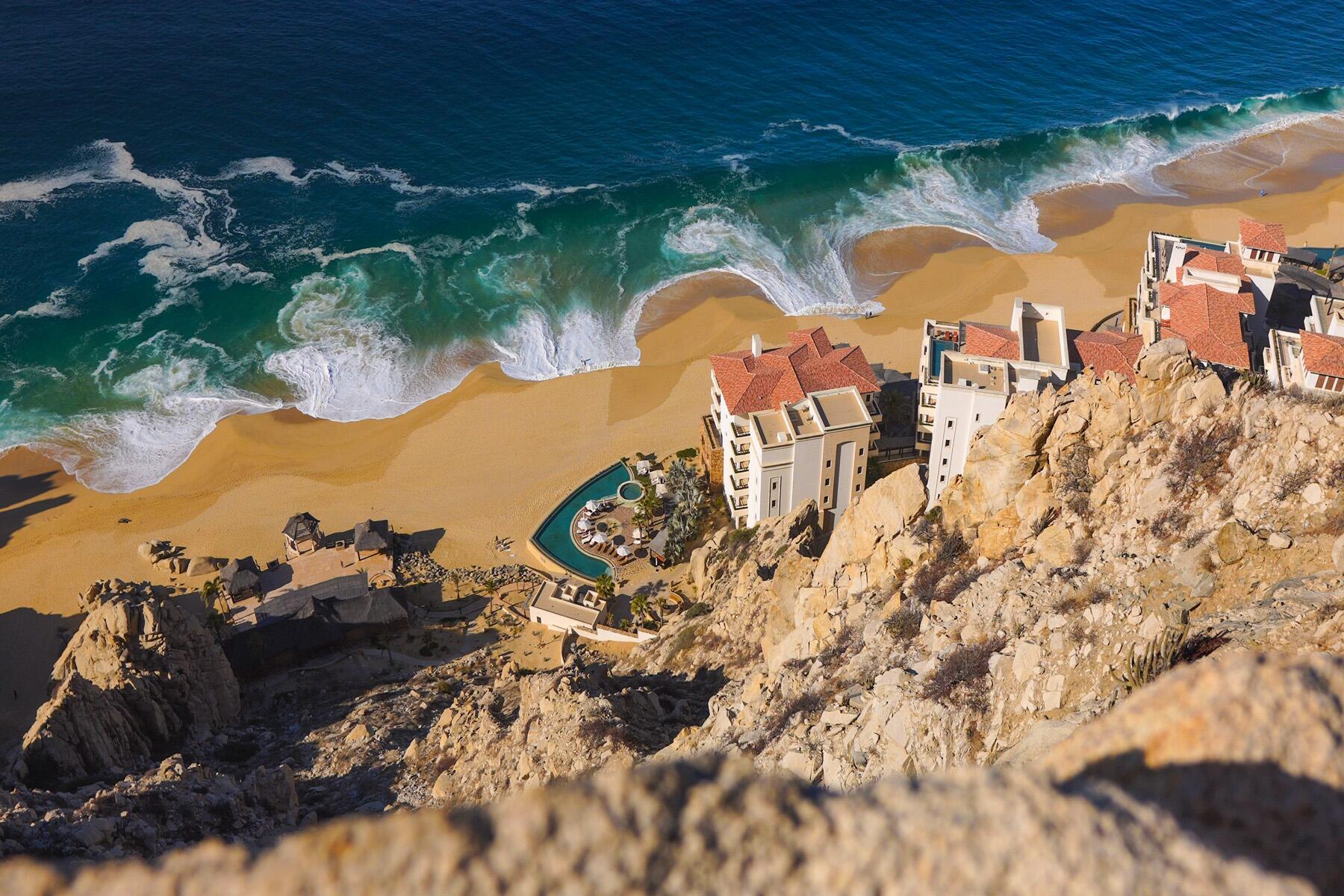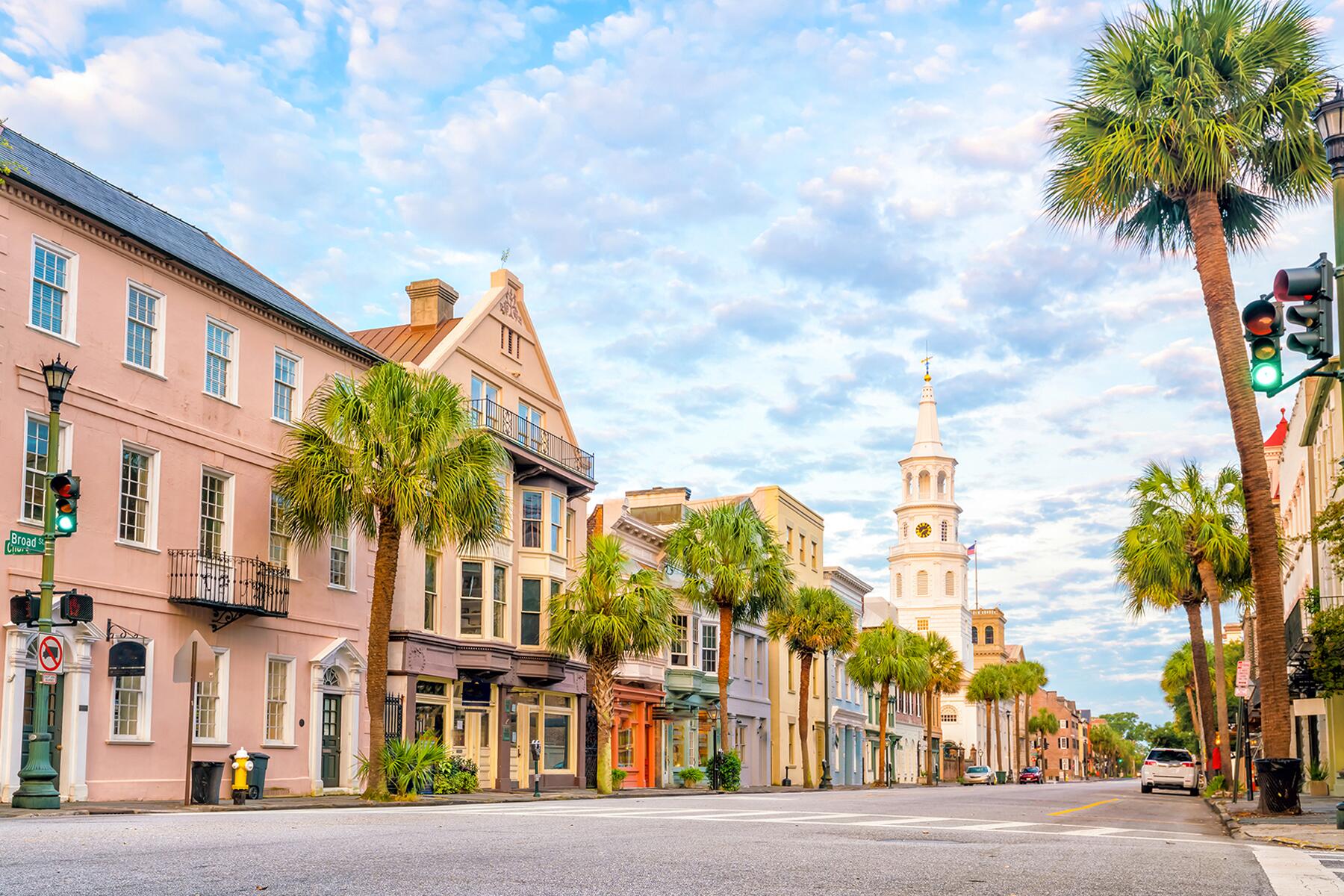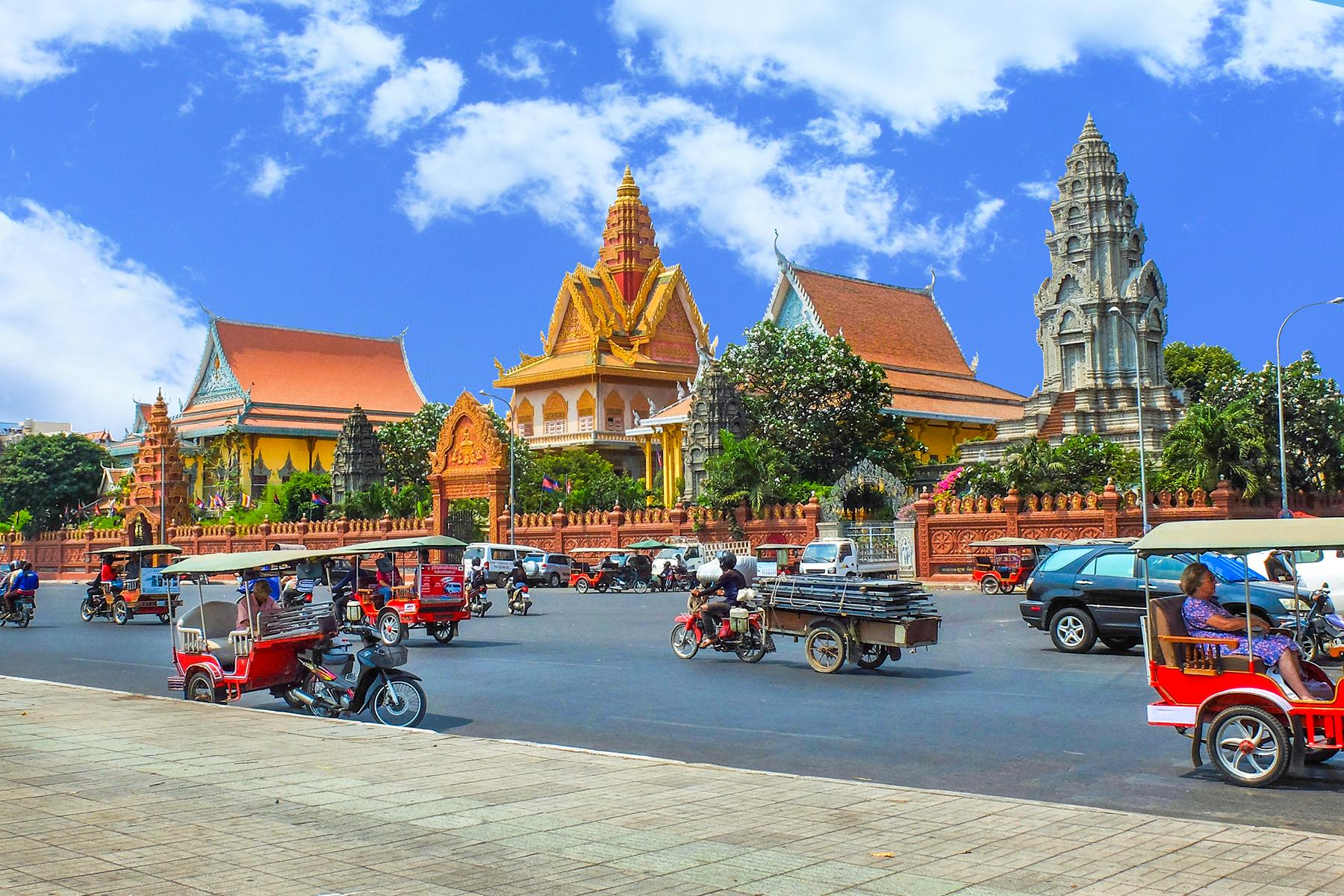From the splendors of Angkor Wat to the serenity of private islands, don’t miss our list of the 25 absolutes must do and see while you’re traveling in Cambodia.
Modern Cambodia is experiencing a new age of progress: new highways, trains, and plenty of quality accommodation and dining options make traveling to Cambodia easy and rewarding. From fast-developing capital Phnom Penh to the majestic Khmer ruins of Angkor Wat near Siem Reap, not forgetting hip Battambang and the southern coastal towns of Kampot and Kep, Cambodia, its nature and its people—among the youngest in the world—can’t be experienced all in one trip. Whether you are going for the first time or return often, here are 25 ideas to help you make the best out of your time in the Kingdom.
Need a place to stay while visiting? We’ve got a great list of hotels for you.
Related: 10 Things You Need to Know Before You Go to Cambodia
Top Picks for You
Cycle Around an Island and Step Back in Time
WHERE: Koh Trong
Floating in the middle of the Mekong right in front of Kratie town, Koh Trong is cast under its own unique spell. With no cars and only a small path for the few motorbikes and bicycles that locals use to get around the island, Koh Trong is light years behind the tourist hustle of other Cambodian cities and islands.
Truth be told, there’s nothing much to do here besides relaxing, pedaling across flat, viridian countryside, visit the traditional stilt homes that dot the coast, and stop to pay respect at one of Koh Trong’s several temples. At night, lounge on the veranda of one of the luxurious wooden homes at Rajabori Villas, while a philharmonic of insect sounds perfectly set the end to any lazy day on the island.
INSIDER TIPYou can rent bicycles at the island’s pier, where locals also offer simple homestays that give an authentic glimpse of life in this remote part of Cambodia.
Chase the Elusive Irrawaddy Dolphin
WHERE: Kratie
The waters next to the village of Kampi, just a short tuk-tuk ride north of Kratie, host a colony of about twenty Irrawady dolphins. They are most active in the early morning and late afternoon, when boatmen shuttle visitors as close as they can. The best time to visit is during the dry season—roughly from November to July—when the dolphins gather in a smaller area, the Mekong’s water levels are less dangerous, and it’s possible to strike off by yourself in a kayak to really get close to this endangered species.
Recommended Fodor’s Video
See the Sunrise at Angkor Wat
WHERE: Siem Reap
The temple complex of Angkor Wat is undeniably the highlight to any visit to Cambodia. Catch a glimpse of the purple sunrise as it glows over its missile-like towers, casting long reflections into the water pond that sits at the left side of the temple’s entrance path. Go armed with patience, as the pond is the most popular spot to shoot Angkor Wat.
INSIDER TIPVisit during the rainy season, when crowds are smaller, and you will have a much more relaxed experience.
Temple Yourself out
WHERE: Siem Reap
Angkor Wat means “Capital Temple” and is just the main building in a complex of more than 50 exquisitely carved ancient Khmer shrines. Hire a tuk-tuk driver for the day, start with sunrise at Angkor Wat, and continue visiting the outlying temples, such as the mysterious Bayon, with its 200 smiling rock faces; or Ta Phrom, with its cascade of tree roots entangled over the temple’s main entrance and roof, made famous by Angelina Jolie’s blockbuster movie Tomb Raider.
Get beyond the obvious sites: travel north of the Angkor Wat complex to less known temples such as the pink sandstone Banteay Srey, and crowds will thin out.
INSIDER TIPWith so many ruins to see, the best way to avoid getting “templed out” is to buy a one-week Angkor Wat pass, and alternate temple exploration with time spent in Siem Reap’s eclectic bars, sampling excellent dining and enjoying its luxe boutique hotels.
Learn About the Genocide
WHERE: Phnom Penh
Cambodia has put its infamous past behind and pushed the pedal to the metal into a future of growth and peace. The capital’s excellent dining scene, art events, and international population reflects the change of times. But when in Phnom Penh, take some time to learn about Cambodia’s horrific past, one of the world’s most recent human tragedies. Visit the Tuol Sleng Museum for one gut-stirring example of how low humans can go. On the southern reaches of town, the Choeung Ek Memorial, better known as “Killing Fields,” has a glass tower filled with skulls. It stands in memory of the thousands killed by the Khmer Rouge’s genocidal regime.
Help Make a Difference at HUSK
WHERE: Siem Reap
Created by the owners of Sojourn Boutique Villas, HUSK Cambodia works directly with local communities to improve their livelihoods, education, and health.
HUSK opened a community school in the village of Kompheim, just outside of Siem Reap. The classrooms are built with biodegradable rubbish — plastic bottles, filled with other plastic, are used in place of bricks. The organization has also built thatched bungalows for many of the students’ impoverished families. You can visit HUSK and help the projects by making a donation, or buying one of the bags and weave-work that local women produce in a studio next to the school.
Shop and Dine at Kandal Village
WHERE: Siem Reap
Siem Reap’s tiny Hup Guan Street, tucked behind busy Samdech Tep Vong Road, is the thriving artery of Kandal Village, a hub of coolness in an otherwise busy tourist city. From the fine dining and live music of popular hangout Village Cafe, to the excellent cuppas of Little Red Fox Espresso, to the fine housewares designed by Louise Loubatiers, and the treatments offered by Frangipani Spa, Kandal Village has something to entice every taste.
Visit a Pepper Farm
WHERE: Kampot
This hip river town at the foot of the Elephant Mountains is surrounded by a series of rolling hills where locals produce some of the world’s most prized pepper. Chefs in New York have used Kampot pepper to make ice cream, and Michelin three-starred French chef Olivier Roellinger waxed lyrical about its olfactory richness and incredible spectrum of flavors.
When in Kampot, you can easily strike off and visit one of the many plantations that dot the surrounding hills. Some are slowly embracing eco-tourism, like Chamkar Damnak, an organic pepper plantation that uses the natural fertilizers of Ratanakiri’s elephants, where guests can experience traditional Khmer countryside as a farm stay.
Discover a Vibrant Art Scene
WHERE: Battambang
Battambang is still under the radar, but it’s Cambodia’s most artistic town. It’s all because of the Phare Ponleu Selpak institute, the country’s oldest art school, which has kept teaching and nurturing arts to the locals and has given birth to the popular Cambodian Circus.
The lanes of Battambang old town host art galleries such as Romcheik 5 Art Space, Sangker Gallery, and Tep Kao Sol. They all exhibit the best work of contemporary pan-Cambodian artists.
Creativity also spills into the town’s eclectic dining and nightlife, with unique spots like old-China-chic cocktail bar Miss Wong Battambang, or French-inspired bistro Libations, set on the street corner of Bric-a-Brac, the most stylish boutique hotel in town.
Related: The Cambodian Version of Cirque du Soleil Must Be Seen to Be Believed
Chase Ghosts at Bokor Hill Station
WHERE: Kampot
Shrouded in clouds and mist for the best part of the year, the collection of French colonial buildings atop Bokor Mountain is a sight to behold. Part of the viridian Preah Monivong National Park, the hill is a great vantage point with views that stretch all the way to Cambodia’s southern coast. Recent Chinese-funded development has refurbished the formerly abandoned—and allegedly haunted—Bokor Palace Hotel, once a casino. But regardless of recent development, reaching the mountain top and taking a stroll around the former luxe buildings left by the French while a sea of clouds blankets the horizon is still a must-do.
Indulge in Refined, High-End Khmer Cuisine
WHERE: Phnom Penh/Siem Reap
Not celebrated internationally like neighboring Thai and Vietnamese cuisines, Khmer gastronomy is on the contrary zesty and delicate, and totally worth discovering. In Phnom Penh, try a luxe dinner in the traditional Mekong-side wooden house of chef Rotanak, who prepares meals with hand-picked, market-fresh ingredients as part of her Mahope Home Dining project, which seeks to revitalize ancient Khmer recipes for modern palates.
In Siem Reap, Sugar Palm and Devatas—the latter set in front of a pre-Angkorian lotus pond on the way to the Banteay Srei temple—continue the legacy of owner Khetana’s family recipes. Try the delicious, souffle-like fish amok, so tender it takes hours to prepare.
Related: 15 Things to Eat and Drink in Cambodia
Admire French Colonial Architecture
WHERE: Battambang, Chloong, and Kampot
Beyond the rapidly growing skyline of capital Phnom Penh, the historical legacy of beautiful French and Chinese buildings and shophouses lives on. In Battambang, the compact old town teems with interesting buildings, in particular, the Governor’s Residence, designed by an Italian architect in the early 1900s, which houses a museum today.
In Chloong, an off the beaten track town south of Kratie, was once a thriving center of French Indochine. Some of its old buildings are being converted into luxury accommodation: try Le Relais De Chloong, an opulent 1916 mansion facing the Mekong River.
At last, the town of Kampot has very interesting Sino-Thai shop houses that dot the streets around the Old Market, where most tourists stay.
Cast Away on Song Saa Private Island
WHERE: Song Saa
Tucked behind Koh Rong, Song Saa is a tiny private isle and the setting of the beautiful resort of the same name. This multi-award winning eco-luxury property—chosen by Fodor’s as one of 2014’s best hotels around the world—raises the hospitality bar by mixing up-cycled wood from old fishing boats with the deluxe fittings of its charming villas on stilts. Private sea-facing pools overlook the pristine waters of a protected marine park, the first in Cambodia. Whatever you choose, Song Saa Private Island’s “barefoot luxury” and attention to detail will make you feel like the most pampered castaway in the world.
Tuck Your Toes in the Sand
WHERE: Koh Rong
One of the biggest tropical islands off the southwestern Cambodian coast still resists major development, and boasts 23 soft sand beaches where the bungalows and small resorts prefer to remain low key. The island’s interior has dense jungle with plenty of great trekking, and the waters around the island offer over 15 dive sites and nice stretches of reef that’s a delight to snorkel.
INSIDER TIPIf you want more than a party holiday, go beyond Koh Touch beach, where the ferries land. Lonely Beach is, as its name suggests, one of the places to go for quiet.
Related: 10 Best Beaches in Cambodia
Hike Till You Drop at Kulen Mountain
WHERE: Siem Reap
This sacred mountain is only 30km north of Angkor Wat, and yet still stays under most travelers’ radars. It’s a rewarding spot for a day hike, with two tall waterfalls—one can reach 20 meters height in the rainy season—archeological sites such as the “River of Linggas”, whose bottom is strewn with what once were phallic rocks, and Cambodia’s largest reclining Buddha statue, set into the Preah Ang Tom temple.
Eat Crab and Relax by the Beach
WHERE: Kep
Only 20km away from Kampot, sleepy Kep hugs the southernmost bend of Cambodia’s coast. A crab statue rises from the sea between the main beach and offshore Rabbit island, honoring the crustacean that’s found aplenty in these shores. Kep’s Crab Market is a no-frills yet interesting place to observe locals at work with their nets and sea cages, with which they catch the delicious fresh crab and fish on offer here daily.
INSIDER TIPIf you don’t mind to rough it up a bit at the Crab Market, you can have a kilogram of fresh crab cooked with Kampot pepper and served with local spices for less than ten dollars.
Enjoy an Artsy and Charming Old Town
WHERE: Kampot
With an unbeatable riverside setting, the Bokor Mountain soaring at the back, and Kep’s beaches in less than an hour away, Kampot is blessed by nature. But don’t forget the motley crew of local and expatriate creatives who have taken up residence in the charming lanes around the town’s Old Market. The mansions of the original Sino-Thai migrants now boast quiet cafes, book stores, and excellent restaurants that range from the perfect Italian food at Divino, to the Asian-fusion mains and cocktails of the beautifully upholstered old Fish Market. It all conjures to make Kampot an exquisite and bohemian town you won’t like to leave anytime soon.
See the Countryside Go by on a Slow Train
As Cambodia re-opened its railways in 2018, soaking countryside and village views from the window of a train is fast becoming a slow travel alternative to Cambodians’ reckless driving.
The newest line connects the Thai border at Poipet to Phnom Penh, stopping at Battambang and Pursat en route. Weekend services roll south of the capital to the coast, with final destination Sihanoukville, and stop at Takeo and vibrant Kampot en route.
INSIDER TIPYou can reach Phnom Penh’s Pochentong Airport using the new shuttle train that leaves from the capital’s train station. All train services throughout the country are free of charge until the end of 2018.
Chase Older, Untouristed Temples
WHERE: Kampong Thom
Set between Phnom Penh and Siem Reap, the ruins near Kampong Thom are 400 years older than Angkor Wat, and yet see much fewer tourists. Hire a tuk-tuk and go to Sambor Prei Kuk, the remains of the pre-Angkorian capital of the Chenla Kingdom, which is being considered as a new Unesco World Heritage Site.
Explore Wild Nature at Ream National Park
WHERE: Sihanoukville
Nestled in the southwestern corner of Cambodia and only 15km away from over-developed Sihanoukville, Ream National Park is the coastal city’s striking natural nemesis. You can trek in primary rainforest or hike to the coastline, where it’s possible to strike off and explore on kayaks. Bird lovers will enjoy the park’s population of Brahminy kite and white-bellied sea eagles, or peek at the timid storks that inhabit the park’s muddy coastal flatlands.
Indulge in Excellent International Dining
WHERE: Phnom Penh
The capital, a hive of international activity, has fast become the country’s most diverse and exciting dining destination. From street-side stalls that fill the air with tangy and piquant smells to lavish European cuisine served in top of the range restaurants, Phnom Penh has something to suit every taste and budget.
Among the best restaurants, try Tepui at the Chinese House, or the curated Khmer set course menus at Cuisine Wat Damnak. For Spanish tapas and European gastronomy with a cause, try Friends the Restaurant, run by an NGO that helps train underprivileged Cambodian youths.
Eat Fried Tarantulas
WHERE: Skuon
They say “if you can’t beat them, eat them”, and in Skuon village, just about an hour drive north of Phnom Penh, the motto eerily refers to the tarantulas that infest the place. Spiders were first eaten all over Cambodia during the harsh years of the Khmer Rouge. In Skuon, locals still hunt, fry, and pile the spiders on trays they exhibit on both sides of the main road, making the village a prime spot to sample Cambodia’s most gross snack.
INSIDER TIPIf you can’t stomach eating the spiders (trust us, few people do) buy one and give it to the local kids. Believe it or not, they love eating the creepy crawlies, and have no problems posing for that perfectly gross photo.
Take a Boat Trip on the Tonle Sap, Cambodia’s Biggest Lake
WHERE: Battambang/Siem Reap
One of Southeast Asia’s biggest lakes, the Tonle Sap occupies the center of Cambodia. It swells and shrinks seasonally based on fluctuations in the Mekong’s water levels. Once a year, the lake’s tributary Tonle Sap experiences a reversal of the flow that Cambodians celebrate with an exciting festival, Bon
INSIDER TIPSlow boats between Siem Reap and Battambang are a popular yet time-consuming way to experience life on the lake.
Witness a Mesmerizing Apsara Dance
WHERE: Phnom Penh/Siem Reap
In Hindu beliefs, Apsaras are celestial spirits of water and cloud, and are central elements to Angkor Wat’s iconography and Cambodian culture. The Apsara dance tries to recapture the moves of the celestial beings, and was almost wiped out during the Khmer Rouge regime.
Today you can still catch a live performance when in Phnom Penh: Cambodian Living Arts and the Souvanna Phum Khmer Art Association are the obvious places to start. In Siem Reap, don’t miss the stunning Apsara Dance performances organized in the gardens of luxe Raffles Grand Hotel d’Angkor.




